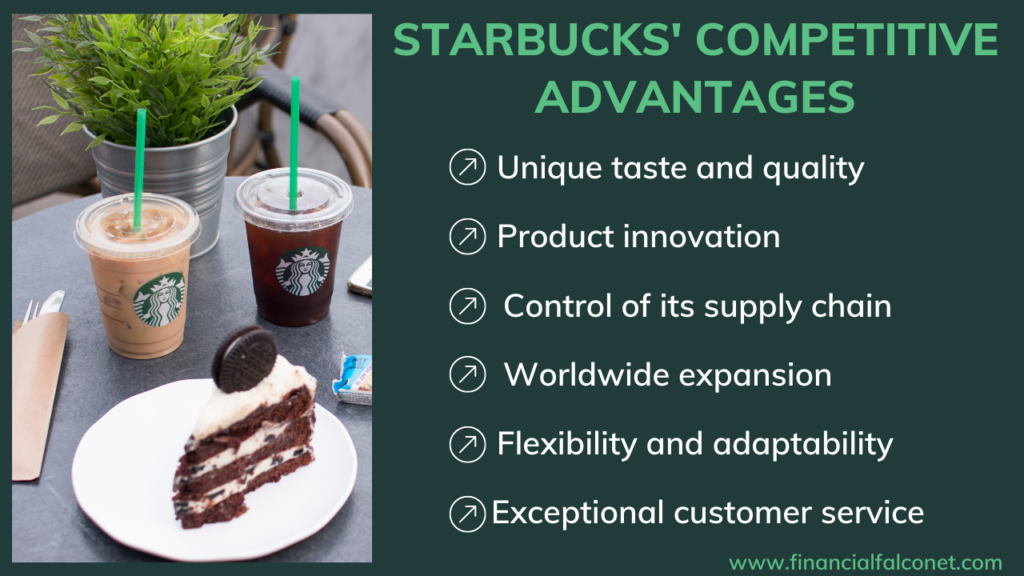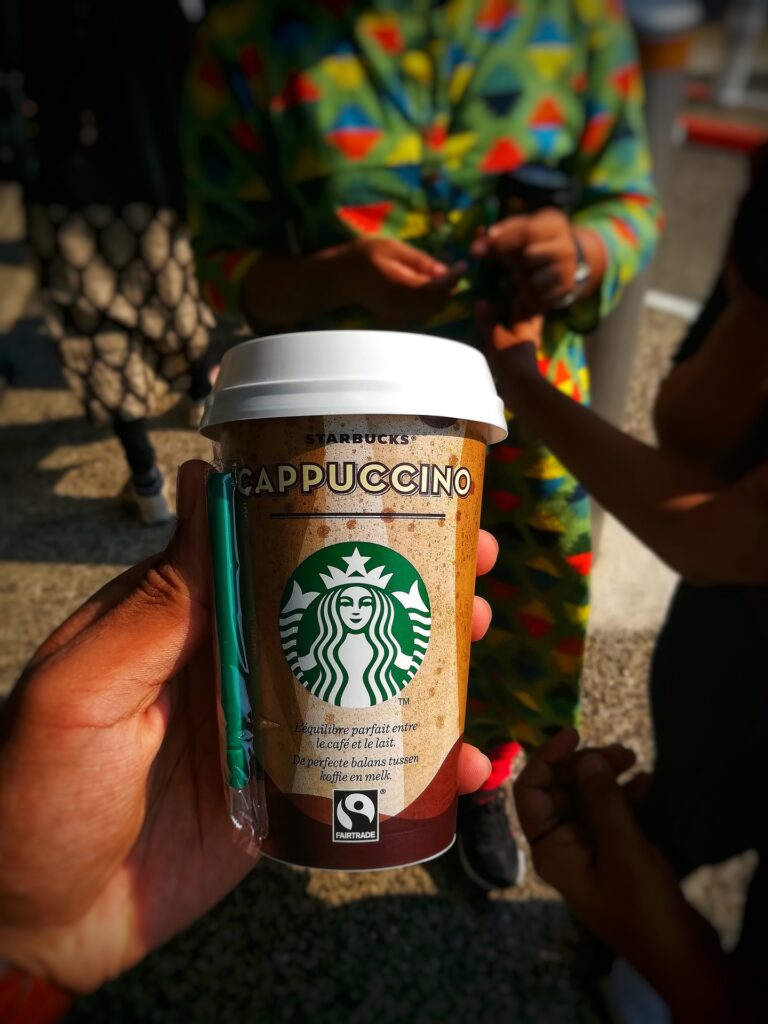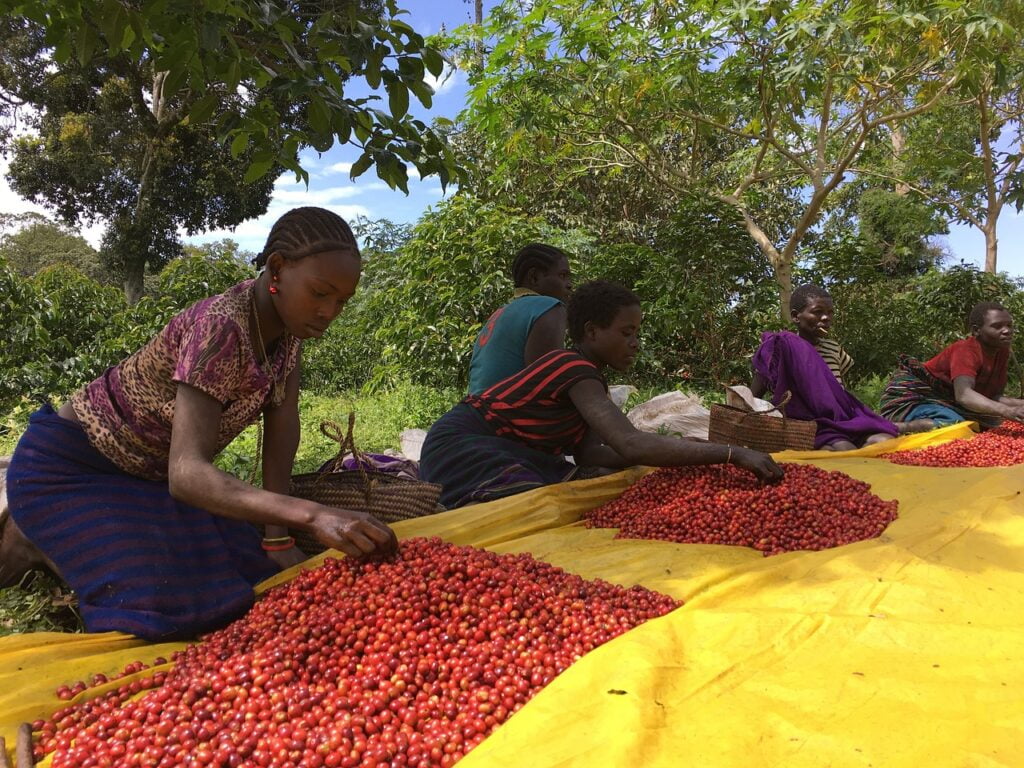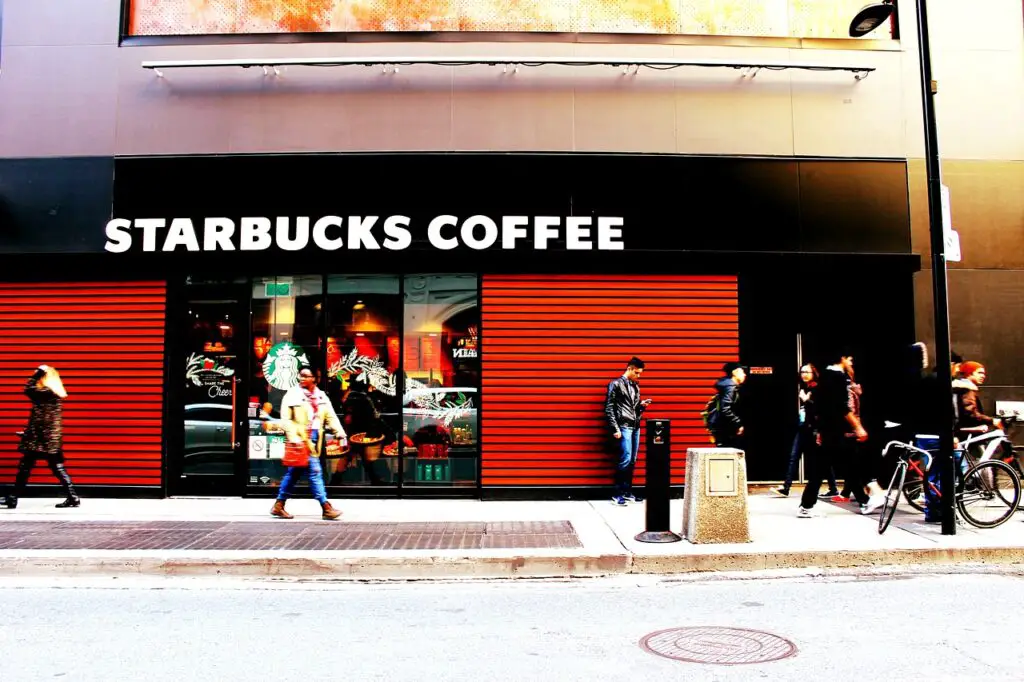Starbucks’ competitive advantage and strategies have contributed significantly to its being the world’s largest coffeehouse based on a business valuation done by Wikipedia.
Starbucks Corporation, commonly referred to as Starbucks is an American multinational chain that was started by Jerry Baldwin, Gordon Bowker, and Zev Siegl. The brand consists of 6 roastery reserves and over 36,000 coffeehouses littered all over the world.
This large number of coffeehouses is one of the key contributors to Starbucks’ competitive advantage and has been achieved due to the company’s competitive strategy of expanding its operations beyond Seattle, where it started, to other parts of the world.
Right from the company’s inception in 1971, it has set out to differentiate itself by inspiring and nurturing the human spirit through the specialty coffee it offers. Hence, another Starbucks competitive advantage in the early years of its operations was offering customers top-quality fresh-roasted coffees. This also served as a differentiation strategy for the brand.
Read about: Nike’s Competitive Advantage and Strategy
What is competitive advantage?
Competitive advantage is an attribute that allows a business corporation to outperform its competitors.
This ability to outperform competitors may be a result of access to cheaper raw materials, having a highly skilled labor force, or operating at a strategic geographical location. It can also result when a brand has access to new or advanced technology and any other asset that enables it to produce goods or provide services at a cheaper rate, with superior quality, or both.
For any business to scale its operations and become successful, that business must deliver a product or service that sets it apart from all other businesses within the same industry. This becomes part of the company’s competitive advantage.
Starbucks has sustained a competitive advantage in the coffee industry by building on its coffee quality and giving customers high-quality coffee. This is captured in a statement by the company’s CEO;
“We are a purpose-driven company with a mission grounded in the human experience as we seek to have a positive impact on both people and the planet, while profitably growing our business.”
Starbucks Chief Executive Officer, Kevin Johnson
Read about: Tesla’s Competitive Advantage and Strategy

Who are Starbucks’ competitors?
Starbucks’ competitors include Dunkin’ Donuts, McCafe, Costa Coffee, Tim Hortons, Subway, Peet’s Coffee, Lavazza, Luckin Coffee, and Folgers.
All companies that operate in the coffee industry especially those involved in the roasting and selling of coffee beans, pre-ground coffee, or ready-to-drink coffee are competitors to Starbucks. These include the Coffee Bean, Café Coffee Day, Maxwell House, Caribou Coffee, Dutch Bros, Café Bustelo, Bewley’s Coffee and Tea, and Café Amazon.
Additional competitors include independent coffeehouses, restaurants, retail stores, or fast-food chains that sell coffee and operate within the same localities as Starbucks such as Whitebread, Yum China, McDonald’s, Community Coffee, 85C Bakery Cafe, and Paris Baguette.
Read about: McDonald’s Competitive Advantage
Starbucks’ competitive strategies
The whole idea of a company’s competitive strategy rests on a 1980 book written by a professor at Harvard Business School, Michael Porter. In the book, he identified 3 competitive strategies that businesses could apply when handling competitors.
These strategies are commonly referred to as Porter’s generic strategies. In some instances, they are also recognized as differential or comparative advantages. They include:
- Cost leadership
- Differentiation
- Focus
These strategies can be applied by both product-based and service-based companies. Let us now look at each of them and examine how Starbucks’ competitive strategies align with each of these strategies.
Cost leadership strategy
This competitive strategy refers to a company’s ability to produce a good or service of the same or better quality as their competitors but sell it at a lower price.
The lower price provides the company with a competitive advantage because consumers gain a price value. And, all things being equal, these consumers are more likely to patronize the business that provides better value for their money.
Starbucks is actively involved in its supply chain by controlling major steps such as the farming, roasting, distribution, and direct selling of coffee. All these contribute to reducing the company’s cost of production and getting their products to consumers.
However, because the company has carved a niche for itself as a premium coffee brand, Starbucks’ competitive strategy does not include using the cost leadership strategy.
Instead, the lower production and distribution costs enable Starbucks to remain profitable and give the company adequate revenue which it utilizes in establishing more coffee outlets around the globe. Hence aiding it to maintain its position as the largest coffeehouse in the world.
Differentiation strategy
Corporations often use the differentiation strategy to create better products or services than their competitors. This competitive strategy generally entails offering a product or service that is distinct relative to other products or services within the same industry.
Using differentiation as a competitive strategy often involves being committed to researching and developing products or services that offer unique value to the consumer. It also involves being creative and innovative in such a way that competitors can not easily replicate the product or service the company offers.
Starbucks’ competitive strategy is focused on this product differentiation as the company has carved a niche for itself within the coffee industry as the producer of top-quality coffee.
The differentiation strategy has been used by Starbucks right from its inception and continues to be the company’s main competitive strategy.

The use of the differentiating strategy by Starbucks can be deduced from how the company began as a roaster and retailer of whole bean and ground coffee, tea, and spices. It can also be seen in the ability of its founding partners, Jerry Baldwin and Gordon Bowker to create their unique blends and flavors of coffee according to Britannica.
After purchasing a used roaster from Holland, the partners, Baldwin and Bowker, experimented with Alfred Peet’s roasting techniques to develop their distinctive blends and flavors.
Starbucks’ use of the differentiation strategy enables the company to charge a little higher for its products when compared to other coffee providers. For instance, as of 9th August 2023, a cup of medium cappuccino cost about $3.99 at McDonald’s while a cup of cappuccino at Starbucks costs about $4.12
Focus strategy
The focus of competitive strategy revolves around niching down a company’s product or service to a particular customer base. This is done by focusing on a specified need of the targeted customer base and signing the company’s products or services to meet that particular need.
Businesses that use the focus competitive strategy often rely on data from consumers to determine the particular market segment they can most effectively and efficiently serve.
In addition to niching down, the business may also have to implement either the cost leadership strategy or the differentiation competitive strategy. This is because combining at least two competitive strategies ensures better outcomes for a business.
Read about: Value Chain of Starbucks: Examples and Analysis
What makes Starbucks different from its competitors?
Starbucks is different from its competitors due to the unique taste of its coffee. This uniqueness in taste can be attributed to Starbucks’ firm control over its supply chain which ensures that the company has guaranteed access to the best quality coffee beans which are roasted based on company guidelines to achieve specific tastes.
The company’s use of custom-made processing machines such as the Mastrena further aids in maintaining the quality and taste of Starbucks’ coffee across all its outlets.
Read about: Disney’s Vertical Integration Strategy and Examples
Starbucks’ competitive advantages
- Unique taste and quality
- Product innovation
- Control of its supply chain
- Worldwide expansion
- Flexibility and adaptability
- Exceptional customer service
Unique taste and quality
The unique taste and quality of its coffee is the main competitive advantage of Starbucks. The company prides itself in making a unique-tasting coffee from the Arabica coffee beans its sources from its farms and other partner suppliers.
The process of sustaining Starbucks’ competitive advantage starts right from the sourcing of raw coffee beans and continues with the diverse roasting techniques employed by the company’s roasteries to produce the different unique tastes that have been associated with their various coffee offerings.
Before its expansion to several locations, the company commonly used a La Marzocco Linea machine which was commonly used by coffeehouses to brew coffee. Over time, the company developed a robust research and development department that has partnered with coffee machine manufacturers to create specialized machines for the company.
An example of an industrial manufacturer that aids Starbucks’ competitive advantage of providing unique taste and quality is Thermoplan AG. This company has collaborated with the global coffeehouse for years. The collaboration has aided in the development of exclusive machines for Starbucks including the Verismo 801, Phanton Espresso machine, and Mastrena.

The distinct taste of Starbucks’ coffee is heightened by the company’s use of specialized industrial expresso machines that can handle the production of multiple cups of coffee in a short period. This change was necessitated by the company’s expansion of its operations worldwide and was also informed by the need to significantly reduce the waiting time for its teeming customers.
Recently, the company has advanced to using custom-made automated machines that can produce multiple blends, retain the unique taste, and produce multiple cups of coffee in the shortest possible time.
The most recent industrial machines used in most Starbucks outlets are the Phanton Espresso machine and the Clover Vertica brewer. The former machine was introduced in 2012 while the latter was introduced in March 2022. These machines ensure consistency and balance in espresso extraction and coffee brewing respectively and are custom-made for just the company.
The exclusive production of these machines for Starbucks adds to its unique competitive advantage as no other coffeehouse has access to these same machines. It also ensures that the brand’s outlets all over the world can offer the same unique taste since they all use the same machines for espresso production and coffee brewing.
Starbucks’ competitive advantage of ensuring it offers consumers the best quality of coffee with a unique taste aligns with the company’s overall strategy of product differentiation. Thus, customers are more willing to pay extra for a cup of Starbucks coffee when compared to other generic coffee brands.
Product innovation
Product innovation is one of Starbucks’ competitive advantages. As a world leader in the coffee industry, the company has consistently experimented with various kinds of coffee blends to ensure it introduces newer products that can meet the ever-evolving consumer preferences.
The Pumpkin spice latte is one of the brand’s seasonal coffee-based favorites that have been continually improved on at Starbucks,
One such product innovation is the creation of the Starbucks Oleato which was unveiled at the Starbucks Reserve Roastery Milan and Starbucks Italy stores in February 2023. This new creation combines Starbucks’ arabica coffee with a spoonful of Partanna cold pressed, extra virgin olive oil.
The Oleato comes in a variety of offerings including Oleato Deconstructed, Oleato Golden Foam Espresso Martini, Oleato Caffè Latte, Oleato Iced Shaken Espresso, and Oleato Golden Foam Cold Brew.
Since its launch in February 2023, Oleato beverages have been available at Starbucks Reserve Roasteries in Chicago, Seattle, and New York. They are also available at select stores in the United States and Japan.
Aside from product innovation in coffee, Starbucks has also applied product innovation to other beverages. One such instance is the consideration of people who are allergic to dairy products or are vegetarians in its product offerings.
The company has substituted dairy with plant-based milk alternatives such as almond milk and soy milk for this particular consumer demography. They have also introduced sugar-free syrups for consumers who do not consume sugar.
The brand also implements product innovation during special holidays such as Christmas and Thanksgiving. They also make available time offers during summer such as the Frozen Pineapple Passionfruit Lemonade, Mocha Cookie Crumble, and Caramel Ribbon Crunch Frappuccino.
The company also utilizes the availability of certain herbs and spices to introduce new flavors during the harvest time of items such as peppermint, cinnamon, and pumpkin sauce.
Starbuck’s competitive advantage in product innovation is well established as the brand is known for constantly updating its menu to suit different seasons and offering consumers better and timely products. This is also in line with the brand’s competitive strategy of product differentiation.
Control of its supply chain
Another way Starbucks has maintained a competitive advantage in the coffee industry is by having control of almost all the steps in its supply chain. The company has established farms and also liaised with coffee farmers around the world to ensure the sustainable production of coffee.
The company’s involvement in the roasting, distribution, and direct sale of its products to consumers eliminates any breakdown in the supply chain process that may arise from the inability of suppliers, contractors, or other partners in keeping up with the aspect of the supply chain they handle.
Starbucks gains a competitive advantage over other coffeehouses that do not have as much control over their supply chain. For instance, while other coffee houses may struggle with sourcing the required quantities of coffee beans at times of scarcity, Starbucks can still have access to a steady supply of coffee beans since the company directly operates coffee plantations.
This high level of Starbucks’ supply chain control enables the company to use any type of pricing strategy they deem fit for their products.
Another competitive advantage that Starbucks has over other coffee chains is the ability to create new coffee varieties by implementing varying roasting techniques. This is possible due to the regional roasting reserves and plants the brand operates.
Starbucks’ competitive advantage as regards controlling its supply chain also ensures that revenue that would have been shared between the company and supplier or other third-party companies gets earned completely by the company. This further enhances the brand’s overall profitability in the long run.
Worldwide expansion
One of the most significant competitive advantages of Starbucks is its move toward expanding its stores worldwide. This is a spinoff from the company’s mission statement of establishing the company as the premier
purveyor of the finest coffee in the world while maintaining its
uncompromising principles as the brand grows.
Starbucks’ expansion started in 1987 when the company opened stores in Chicago and Vancouver, Canada. It then expanded to Washington, D.C., California, and New York. By 1996, the brand expanded outside North America to Japan and Singapore, followed by Malaysia, New Zealand, Taiwan, Thailand, and the United Kingdom in 1998.
By 1999, Starbucks expanded to China, Kuwait, Lebanon, and South Korea. It opened stores in Australia, Bahrain, Hong Kong, Qatar, Saudi Arabia, and the United Arab Emirates in 2000. Between 2001 and 2002, the brand expanded to Austria, Switzerland, Germany, Greece, Indonesia, Mexico, Oman, Puerto Rico, and Spain.

Every year, the company builds on its existing presence to open more stores across the countries where they operate and they currently have stores in Africa, Asia, Europe, North America, Oceania, and South America.
Starbucks has continually expanded its presence through the years and had over 36,000 stores worldwide as of 2022. The company has been able to achieve this feat by opening new stores yearly in countries where they had previously not had operating.
Another factor that has strengthened this aspect of Starbucks’ competitive advantage is its utilization of partnerships and licensing deals to expand its presence. For instance, between 1998 to 2010, the company opened over 120 stores in underserved neighborhoods through a joint-venture partnership with the former Laker, Magic Johnson.
The aim of opening stores in underserved areas served as a means of uplifting such communities through the provision of job opportunities for the locals. It also serves as a place of communal bond where family, friends, or colleagues could enjoy a cup of Starbucks’ specialty coffees amid conversations.
Another strategy that has aided the expansion is going beyond siting Starbucks stores in high-traffic areas to other high-brow areas with less traffic but, an available consumer base for its products.
The worldwide expansion of Starbucks and the large number of outlets it operates further makes it a well-recognized coffeehouse all over the globe.
All these have combined to grant Starbucks a significant competitive advantage over independent coffee houses that do not have a worldwide presence.
Flexibility and adaptability
Flexibility and adaptability are key attributes in Starbuck’s competitive advantage because for any business to thrive beyond its competitor, such a business must adapt to challenging situations to thrive and must also be flexible to changing consumer preferences.
For instance, instead of opening only dine-in outlets, the company operates drive-thrus and walk-thru, especially in suburban areas and the outer edges of urban areas. These outlet variants portray the company’s flexibility and willingness to serve customers who are on the move.
Starbucks has also expanded its menu beyond coffee to include other beverages, breakfast items, and brunch offerings such as sandwiches, cakes, and egg bites. This was done to offer consumers some room to enjoy the brand’s unique coffee blends alongside other fast-food items that they crave.
The company has also infused time-based offerings, especially during summertime to provide a variety of cold and refreshing beverages to its teeming customers.
This effective utilization of flexibility as well as adaptability grants Starbucks a good level of competitive advantage over other coffee houses that have refused to adopt flexibility and adaptability to grow beyond serving only coffee.
Exceptional customer service
Starbucks’ competitive advantage also lies in the exceptional customer service the brand offers consumers. All over the world, the company’s baristas welcome consumers to the shop with their green aprons and smiley faces.
This positive welcome is not far-fetched as it reflects the company’s impact on its employees through the barista training they provide as well as their referring to their baristas as partners. Indeed, these employees are partners of the company because as far back as 1988, Starbucks offered full health benefits to eligible full- and part-time employees, including coverage for domestic partnerships.
Starbucks’ offering of stock options to its employees both full-time and part-time starting in 1991 has also shown that the brely sees its employees as partners and is committed to providing the necessary benefits to its employees. The company has also initiated a stock purchase plan and opportunities for higher learning for its baristas or partners as the brand calls them.
In light of these, the partners ensure that consumers get the best customer service possible whenever they visit any Starbucks outlet. The positive consumer experience fosters the brand image among consumers and strengthens the brand’s position in the coffee industry.

It also fosters the company’s position in the mind of customers as the third place away from home and work where individuals or groups can enjoy time together or alone in the comfortable and relaxed environment of Starbucks’ outlets. Thus, the company enjoys more competitive advantages over its competitors.
Company initiatives such as the creation of the Starbucks rewards program where customers get a reward for every dollar spent at the company’s stores have been a useful tool in building their customer base as well as loyalty to the brand. The use of technology to ease the purchase and payment of products through the Starbucks app has further aided the positive consumer experience.
Unlike other coffee houses that use number tags for orders, the partners ask customers for their names and use them when the specific order is ready. This provides an additional custom experience for the customer as they are seen not just as a random number but as individuals contributing to the company’s bottom line.
In these ways, Starbucks’ competitive advantage in offering exceptional customer service sets it apart in the industry.
Read about: Companies with Vertical Integration Strategies
What is Starbucks’ main competitive advantage?
The main competitive advantage of Starbucks is the unique blends of coffee it offers customers. This is made possible due to Starbucks’ vertical integration of its supply chain processes which has enabled the company to own a coffee farm in Costa Rica. They also have roasting plants in different regions where coffee production is high.
Hence, instead of having a coffee supply from only one region, if they were dependent on suppliers, Starbucks can access different flavors from different regions because they have vertically integrated their business coupled with their experimentation of different roasting methods.
These ensure that the final coffee product that the company serves customers in its outlets provides satisfaction due to its distinct flavors.
Conclusion
Starbucks’ competitive advantages include its flexibility, worldwide presence, exceptional consumer experience, adaptability, unique taste and quality as well as the vertical integration of its supply chain.
All these when combined with Starbuck’s differentiation strategy establish the brand as a renowned coffeehouse that has a wide competitive advantage over its competitors.
Read about: Horizontal Integration Examples of Companies
Last Updated on November 2, 2023 by Nansel Nanzip BongdapBlessing's experience lies in business, finance, literature, and marketing. She enjoys writing or editing in these fields, reflecting her experiences and expertise in all the content that she writes.

